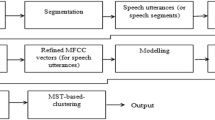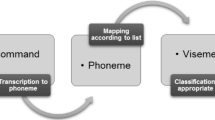Abstract
There are numerous multimedia applications such as talking head, lip reading, lip synchronization, and computer assisted pronunciation training, which entices researchers to bring clustering and analyzing viseme into focus. With respect to the fact that clustering and analyzing visemes are language dependent process, we concentrated our research on Persian language, which indeed has suffered from the lack of such study. To this end, we proposed a novel adopting image-based approach which consists of four main steps including (a) extracting the lip region, (b) obtaining Eigenviseme of each phoneme considering coarticulation effect, (c) mapping each viseme into its subspace and other phonemes’ subspaces in order to create the distance matrix so as to calculate the distance between viseme’s cluster, and finally (d) comparing similarity of each viseme based on the weight value of reconstructed one. In order to indicate the robustness of the proposed algorithm, three sets of experiments were conducted on Persian and English databases in which Consonant/Vowel and Consonant/Vowel/Consonant syllables were examined. The results indicated that the proposed method outperformed the observed state-of-the-art algorithms in feature extraction, and it had a comparable efficiency in generating adequate clusters. Moreover, obtained results reached a milestone in grouping Persian visemes with respect to the perceptual test given by volunteers.











Similar content being viewed by others
Notes
C is stand for Consonant and V is stand for Vowel
References
Bälter O, Engwall O, Öster A-M, Kjellström H (2005) Wizard-of-Oz test of ARTUR: a computer-based speech training system with articulation correction. Paper presented at the proceedings of the 7th international ACM SIGACCESS conference on computers and accessibility, Baltimore, MD, USA
Bastanfard A, Aghaahmadi M, Kelishami A, Fazel M, Moghadam M (2009) Persian viseme classification for developing visual speech training application advances in multimedia information processing—PCM 2009. In: Muneesawang P, Wu F, Kumazawa I, Roeksabutr A, Liao M, Tang X (eds) Lecture notes in computer science, vol 5879. Springer, Berlin, pp 1080–1085
Bastanfard A, Fazel M, Kelishami AA, Aghaahmadi M (2009) A comprehensive audio-visual corpus for teaching sound persian phoneme articulation. Paper presented at the Proceedings of the 2009 IEEE international conference on Systems, Man and Cybernetics, San Antonio, TX, USA
Bastanfard A, Fazel M, Kelishami A, Aghaahmadi M (2010) The Persian linguistic based audio-visual data corpus, AVA II, considering coarticulation. Advances in multimedia modeling. In: Boll S, Tian Q, Zhang L, Zhang Z, Chen Y-P (eds) Lecture notes in computer science, vol 5916. Springer, Berlin, pp 284–294
Bastanfard A, Rezaei NA, Mottaghizadeh M, Fazel M (2010) A novel multimedia educational speech therapy system for hearing impaired children. Paper presented at the proceedings of the advances in multimedia information processing, and 11th Pacific Rim conference on Multimedia: Part II, Shanghai, China
Belkin M, Niyogi P (2001) Laplacian eigenmaps and spectral techniques for embedding and clustering. Adv Neural Inf Process Syst 14:585–591
Benguerel A-P, Pichora-Fuller MK (1984) Coarticulation effects in lipreading. J Speech Hear Res 25(4):600–607
Ezzat T, Poggio T (2000) Visual speech synthesis by morphing visemes. Int J Comput Vision 38(1):45–57
Fisher CG (1968) Confusions among visually perceived consonants. J Speech Hear Res 11:796–804
Garcia C, Zikos G, Tziritas G (1998) A wavelet-based framework for face recognition. Paper presented at the workshop on advances in facial image analysis and recognition technology, 5th European conference on computer vision
Harris C, Stephens M (1988) A combined corner and edge detector. Paper presented at the proceedings of the 4th Alvey vision conference
Hartigan JA, Wong MA (1977) Algorithm AS 136: a K-means clustering algorithm. J R Stat Soc Ser C (Appl Stat) 28(1):100–108
Henton C, Edelman B (1996) Generating and manipulating emotional synthetic speech on a personal computer. Multimed Tools Appl 3(2):105–125
http://www.ldc.upenn.edu/Catalog/CatalogEntry.jsp?catalogId=LDC2009V01 Audiovisual database of spoken American English. Accessed 13th December 2011
Joe H, Ward J (1963) Hierarchical grouping to optimize an objective function. J Am Stat Assoc 58(301):236–244
Karabalkan H, Erdoğan H (2007) Audio-visual speech recognition in vehicular noise using a multi-classifier approach. Paper presented at the DSP for in-Vehicle and Mobile Systems, Istanbul, Turkey
Kjellstrm H, Engwall O, Abdou S, Balter O (2007) Audio-visual phoneme classification for pronunciation training applications paper presented at the 8th Annual Conference of the International Speech Communication Association
Kjellström H, Engwall O (2009) Audiovisual-to-articulatory inversion. Speech Commun 51(3):195–209
Kohonen T (1990) The self-organizing map. Proc IEEE 78(9):1464–1480
Krňoul Z, Císař P, Železný M, Holas J (2005) Viseme analysis for speech-driven facial animation for Czech audio-visual speech synthesis. Paper presented at the SPECOM, Moscow, Russia
Lehiste I, Shockey L (1972) Coarticulation effects in the identification of final plosives. J Acoust Soc Am 51(1A):101
Leszczynski M, Skarbek W (2005) Viseme classification for talking head application computer analysis of images and patterns. In: Gagalowicz A, Philips W (eds) Lecture notes in computer science, vol 3691. Springer, Berlin, pp 773–780
Lofqvist A (2009) Vowel-to-vowel coarticulation in Japanese: the effect of consonant duration. J Acoust Soc Am 125(2):636–639
Mansoorizadeh M, Charkari NM (2010) Multimodal information fusion application to human emotion recognition from face and speech. Multimed Tools Appl 49(2):277–297
Melenchon J, Simo J, Cobo G, Martinez E (2007) Objective viseme extraction and audiovisual uncertainty: estimation limits between auditory and visual modes. Paper presented at the International Conference on Auditory-Visual Speech Processing
Möttönen R, Olivés J, Kulja J, Sams M (2000) Parameterized visual speech synthesis and its evaluation Proc. of EUSIPCO 2000, Tampere, Finland
Nefian AV, Liang L, Pi X, Liu X, Mao C, Murphy K (2002) A coupled HMM for audio-visual speech recognition. In: Proceedings of ICASSP‘02
Potamianos G, Graf HP, Cosatto E (1998) An image transform approach for HMM based automatic lipreading. International Conference on Image Processing ICIP (3):173–177
Potamianos G, Neti C, Luettin J, Matthews I (2004) Audiovisual automatic speech recognition: an overview. Issues inb Visual and Audio-Visual Speech Processing, MIT Press
Safabakhsh R, Mirzazadeh F. AUT-Talk: a farsi talking head. In: information and communication technologies, 2006. ICTTA ‘06. 2nd, 0-0 0 2006, pp 2994–2998
Salah W, Walid M, Abdelmajid H (2007) Lip localization and viseme classification for visual speech recognition. Int J Comput Inf Sci 5(1):62–75
Scholkopf B, Smola AJ, Muller K-R (1998) Nonlinear component analysis as a kernel eigenvalue problem. Neural Comput 10(5):1299–1319
Shaw R, Laplante PA, Salinas J, Riccone R (1996) A multimedia speech learning system for the hearing impaired. Multimed Tools Appl 3(1):55–70
Tiddeman B, Perrett D (2002) Prototyping and transforming visemes for animated speech. Paper presented at the proceedings of the computer animation
Turk M, Pentland A (1991) Eigenfaces for recognition. J Cogn Neurosci 3(1):71–86
Visser M, Poel M, Nijholt A (1999) Classifying visemes for automatic lipreading. Paper presented at the Proceedings of the Second International Workshop on Text, Speech and Dialogue
Waters K, Levergood T (1995) DECface: a system for synthetic face applications. Multimed Tools Appl 1(4):349–366
Williams JJ, Rutledge JC, Katsaggelos AK, Garstecki DC (1998) Frame rate and viseme analysis for multimedia applications to assist speechreading. J VLSI Signal Process 20(1):7–23
Yu K, Jiang X, Bunke H (2002) Sentence lipreading using hidden Markov model with integrated grammar. In: Hidden Markov models. World Scientific Publishing Co., Inc., pp 161–176
Author information
Authors and Affiliations
Corresponding author
Rights and permissions
About this article
Cite this article
Aghaahmadi, M., Dehshibi, M.M., Bastanfard, A. et al. Clustering Persian viseme using phoneme subspace for developing visual speech application. Multimed Tools Appl 65, 521–541 (2013). https://doi.org/10.1007/s11042-012-1128-7
Published:
Issue Date:
DOI: https://doi.org/10.1007/s11042-012-1128-7




